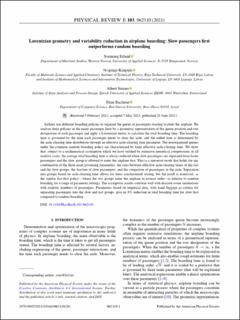| dc.contributor.author | Erland, Sveinung | |
| dc.contributor.author | Kaupužs, Jevgenijs | |
| dc.contributor.author | Steiner, Albert | |
| dc.contributor.author | Bachmat, Eitan | |
| dc.date.accessioned | 2022-01-27T10:05:45Z | |
| dc.date.available | 2022-01-27T10:05:45Z | |
| dc.date.created | 2021-12-08T14:05:46Z | |
| dc.date.issued | 2021 | |
| dc.identifier.citation | Erland, S., Kaupužs, J., Steiner, A., & Bachmat, E. (2021). Lorentzian geometry and variability reduction in airplane boarding: Slow passengers first outperforms random boarding. Physical Review E, 103(6):062310 | en_US |
| dc.identifier.issn | 2470-0045 | |
| dc.identifier.uri | https://hdl.handle.net/11250/2881982 | |
| dc.description.abstract | Airlines use different boarding policies to organize the queue of passengers waiting to enter the airplane. We analyze three policies in the many-passenger limit by a geometric representation of the queue position and row designation of each passenger and apply a Lorentzian metric to calculate the total boarding time. The boarding time is governed by the time each passenger needs to clear the aisle, and the added time is determined by the aisle-clearing time distribution through an effective aisle-clearing time parameter. The nonorganized queues under the common random boarding policy are characterized by large effective aisle-clearing time. We show that, subject to a mathematical assumption which we have verified by extensive numerical computations in all realistic cases, the average total boarding time is always reduced when slow passengers are separated from faster passengers and the slow group is allowed to enter the airplane first. This is a universal result that holds for any combination of the three main governing parameters: the ratio between effective aisle-clearing times of the fast and the slow groups, the fraction of slow passengers, and the congestion of passengers in the aisle. Separation into groups based on aisle-clearing time allows for more synchronized seating, but the result is nontrivial, as the similar fast-first policy—where the two groups enter the airplane in reverse order—is inferior to random boarding for a range of parameter settings. The asymptotic results conform well with discrete-event simulations with realistic numbers of passengers. Parameters based on empirical data, with hand luggage as criteria for separating passengers into the slow and fast groups, give an 8% reduction in total boarding time for slow first compared to random boarding. | en_US |
| dc.language.iso | eng | en_US |
| dc.publisher | American Physical Society | en_US |
| dc.rights | Navngivelse 4.0 Internasjonal | * |
| dc.rights.uri | http://creativecommons.org/licenses/by/4.0/deed.no | * |
| dc.title | Lorentzian geometry and variability reduction in airplane boarding: Slow passengers first outperforms random boarding | en_US |
| dc.type | Peer reviewed | en_US |
| dc.type | Journal article | en_US |
| dc.description.version | publishedVersion | en_US |
| dc.source.volume | 103 | en_US |
| dc.source.journal | Physical review E | en_US |
| dc.source.issue | 6 | en_US |
| dc.identifier.doi | 10.1103/PhysRevE.103.062310 | |
| dc.identifier.cristin | 1966256 | |
| dc.source.articlenumber | 062310 | en_US |
| cristin.ispublished | true | |
| cristin.fulltext | original | |
| cristin.qualitycode | 1 | |

